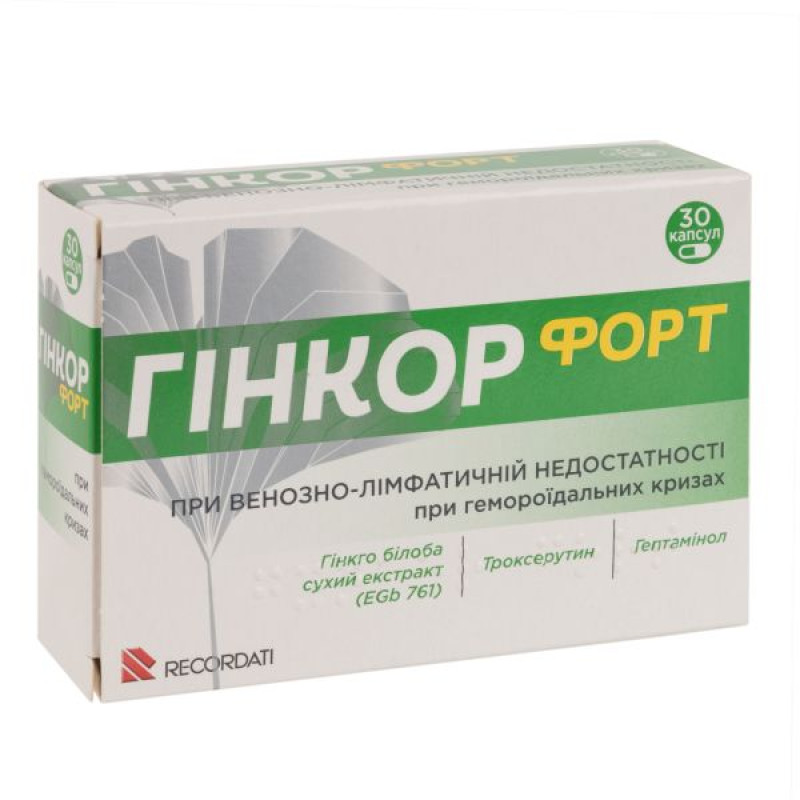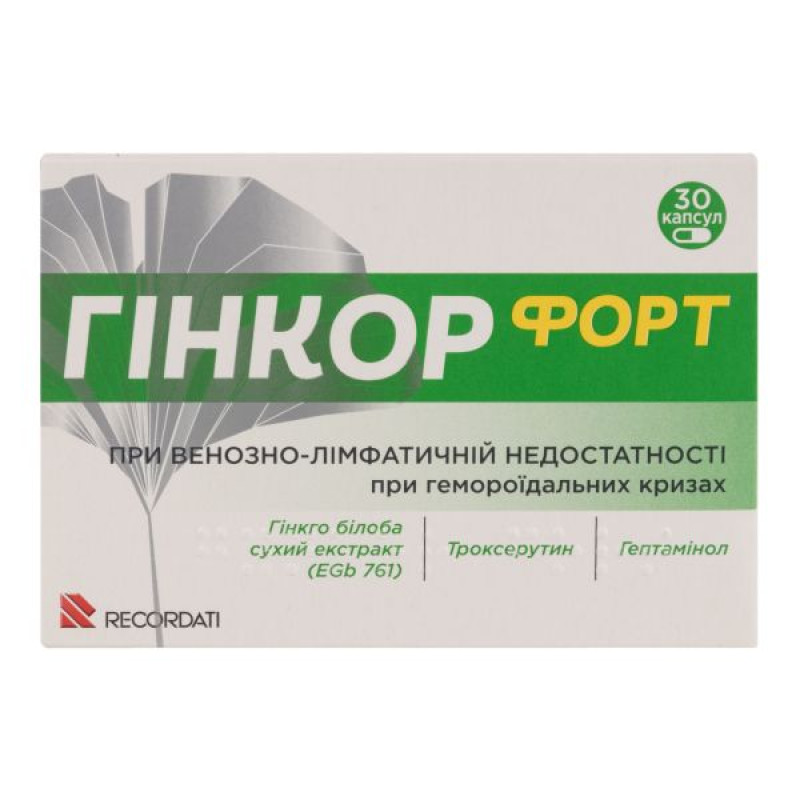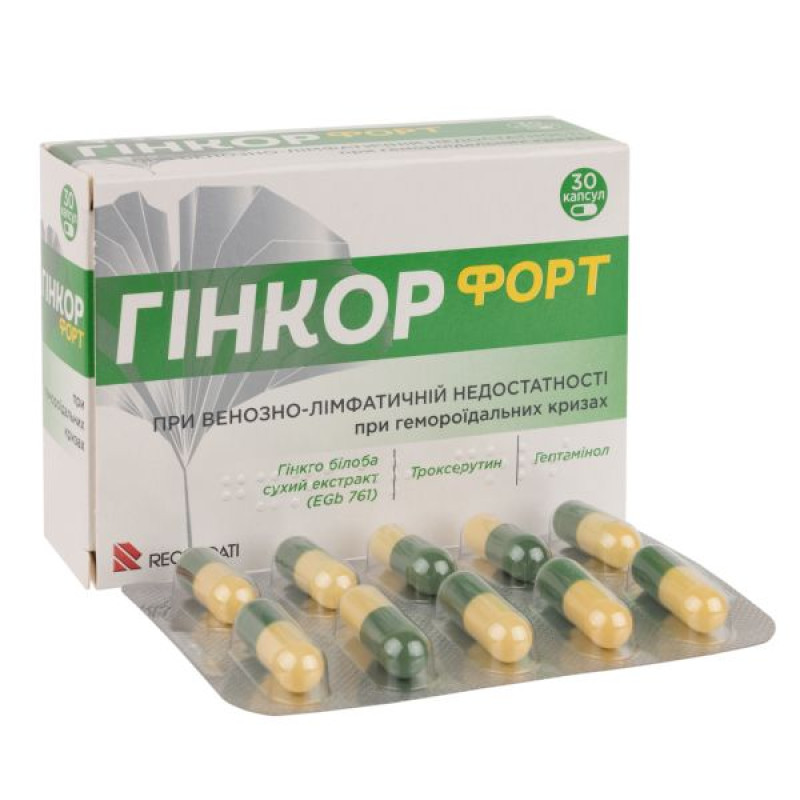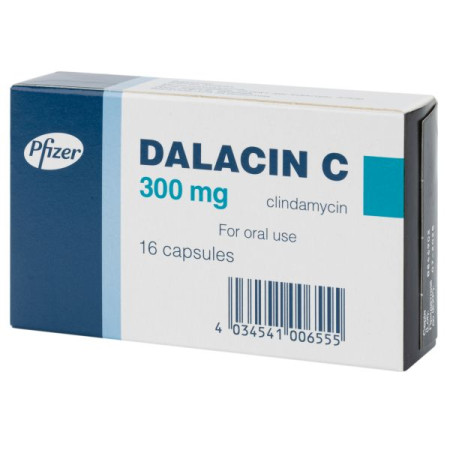Ginkor fort capsules No. 30

Instructions Ginkor Fort capsules No. 30
Composition
active ingredients: 1 capsule contains Ginkgo biloba dry extract (EGb 761) 14 mg; heptaminol hydrochloride 300 mg; troxerutin 300 mg;
excipients: colloidal anhydrous silicon dioxide, magnesium stearate;
capsule composition: iron oxide yellow (E 172), indigotine (E 132), titanium dioxide (E 171), gelatin.
Dosage form
Capsules.
Main physicochemical properties: capsules with an opaque green cap and an opaque yellow body, containing a pale yellow compressed powder.
Pharmacotherapeutic group
Vasoprotectors. Capillary stabilizing agents. Bioflavonoids. Troxerutin combinations.
ATX code C05C A54.
Pharmacodynamics
The drug is a venotonic and angioprotective agent that increases venous tone, regulates the filling of the venous bed, and reduces the permeability of the vascular wall.
The drug has the ability to locally inhibit certain pain and inflammation inhibitors (histamine, bradykinin, serotonin), lysosomal enzymes, and free radicals that lead to inflammation and degeneration of collagen fibers.
The drug stimulates venous return due to the presence of heptaminol hydrochloride in its composition.
Pharmacokinetics
Pharmacokinetic studies in humans have not been conducted.
Indication
Symptomatic treatment of venous-lymphatic insufficiency, manifested by a feeling of heaviness, paresthesia and pain in the legs. Treatment of functional symptoms associated with hemorrhoidal crisis.
Contraindication
Hypersensitivity to active or excipients, gastric and duodenal ulcer, chronic gastritis (in the acute phase).
Since the drug contains heptaminol, it should not be used in hyperthyroidism; also, it should not be used simultaneously with monoamine oxidase inhibitors due to the risk of arterial hypertension.
Special safety precautions
Since the drug contains heptaminol, blood pressure should be monitored at the beginning of treatment in patients with severe forms of arterial hypertension.
Given the presence of Ginkgo biloba (EGb 761) in the composition of the medicinal product, it is recommended to carefully monitor patients who are simultaneously taking medicinal products metabolized by cytochrome P450 3A4. There is no information on the abuse of Ginkgo biloba (EGb 761). Given the pharmacological characteristics of the medicinal product, Ginkgo biloba (EGb 761) has no potential for abuse.
Patients with a tendency to bleed (hemorrhagic condition) and concomitantly treated with anticoagulants and antiplatelet drugs should consult a doctor before taking this medicine.
Medicines containing ginkgo may increase the tendency to bleed. Therefore, this medicine should be stopped 3 to 4 days before any surgery.
In patients with epilepsy, the potential for additional seizures caused by taking ginkgo-containing medications cannot be ruled out.
Concomitant use of drugs containing ginkgo and efavirenz is not recommended.
Hemorrhoidal crisis: this medicine should not be used as a specific treatment for other rectal diseases. Treatment should be short-term. If symptoms do not disappear quickly, a proctological examination should be performed and the course of treatment reviewed.
Venous-lymphatic insufficiency: to enhance the effectiveness of the drug, it is necessary:
Avoid exposure to the sun and heat, prolonged standing, and weight gain; prolonged walking and wearing support stockings ensure venous circulation.
Heptaminol, which is part of the drug, may cause a positive reaction during doping control in athletes.
Interaction with other medicinal products and other types of interactions
It is contraindicated to use the drug simultaneously with MAO inhibitors, as an increase in blood pressure is possible due to the presence of heptaminol in the drug.
Results of clinical interaction studies with Ginkgo biloba (EGb 761) have shown potentiation or inhibition of cytochrome P450 isoenzymes. Midazolam concentrations were altered after concomitant administration of Ginkgo biloba (EGb 761), suggesting an interaction via CYP3A4. Therefore, medicinal products that are primarily metabolised by CYP3A4 and have a narrow therapeutic index should be used with caution.
If this medicine is taken simultaneously with anticoagulants (phenprocoumon, warfarin) or antiplatelet drugs (clopidogrel, acetylsalicylic acid or other non-steroidal anti-inflammatory drugs), their effect may be altered.
An interaction study with talinolol has shown that ginkgo may inhibit intestinal p-glycoprotein. This may increase the exposure of drugs that are sensitive to intestinal p-glycoprotein, such as dabigatran etexilate. Precautions should be taken when ginkgo and dabigatran are used concomitantly.
An interaction study has shown that Cmax for nifedipine may be increased by ginkgo. In some individuals, this increase may be up to 100% with dizziness and increased intensity of hot flashes.
Concomitant use of ginkgo-containing products and efavirenz is not recommended. Plasma concentrations of efavirenz may be decreased due to induction of CYP3A4.
Application features
The drug should be prescribed with caution to patients with severe liver and gallbladder diseases.
Ability to influence reaction speed when driving vehicles or other mechanisms
No studies have been conducted to assess the effect on the reaction speed when driving or using other mechanisms. However, dizziness may impair the ability to drive or use other mechanisms.
Use during pregnancy or breastfeeding
This medicine should not be used during pregnancy due to the vasoactive effect of heptaminol and the anti-aggregatory activity of Ginkgo biloba (EGb 761).
It is not known whether the drug passes into breast milk, so it is not recommended to take it during breastfeeding.
Method of administration and doses
Venous-lymphatic insufficiency: 1 capsule twice a day, morning and evening. Hemorrhoidal crises: 3–4 capsules per day with meals. The duration of treatment as part of complex therapy is 7 days.
It is advisable to take the medicine with meals.
Children
There is insufficient clinical experience with the use of the drug in children, therefore the drug should not be used in pediatric practice.
Overdose
Symptoms: Adverse reactions may worsen.
Treatment. Stop taking the drug. It is recommended to induce vomiting or perform gastric lavage and carry out symptomatic treatment. If necessary, peritoneal dialysis can be prescribed.
Adverse reactions
Depending on the frequency, adverse reactions are divided into the following categories: very common (≥ 1/10), common (≥ 1/100, < 1/10), uncommon (≥ 1/1000, < 1/100), rare (≥ 1/10000, < 1/1000), very rare (< 1/10000), with an unknown frequency (available data do not allow to estimate the frequency of these reactions).
The following side effects may occur very rarely:
Gastrointestinal disorders: upper abdominal pain, epigastric discomfort, nausea, diarrhea, dyspepsia, flatulence; Nervous system disorders: headache, dizziness, syncope (including vasovagal), sleep disorders; Skin and subcutaneous tissue disorders: hypersensitivity, anaphylactic reactions, including angioedema, urticaria, dyspnea, itching, allergic dermatitis (eczematous), rash, skin inflammation, redness, ecchymoses; severe allergic reactions; General disorders: fatigue;
Cardiac disorders (frequency unknown): hypertension.
Reporting of suspected adverse reactions
Reporting suspected adverse drug reactions is important. This allows the benefit-risk balance of the medicine to be monitored. Healthcare professionals are asked to report any suspected adverse reactions via the national reporting system.
Expiration date
3 years.
Storage conditions
Store in original packaging at a temperature not exceeding 30 ° C. Keep out of the reach of children.
Packaging
10 capsules in a blister, 3 blisters in a cardboard box.
Vacation category
Without a prescription.
Producer
BOFUR IPSEN INDUSTRIES.
Location of the manufacturer and its business address
Rue Ete Virton 28100 Droit, France.
There are no reviews for this product.
There are no reviews for this product, be the first to leave your review.
No questions about this product, be the first and ask your question.









